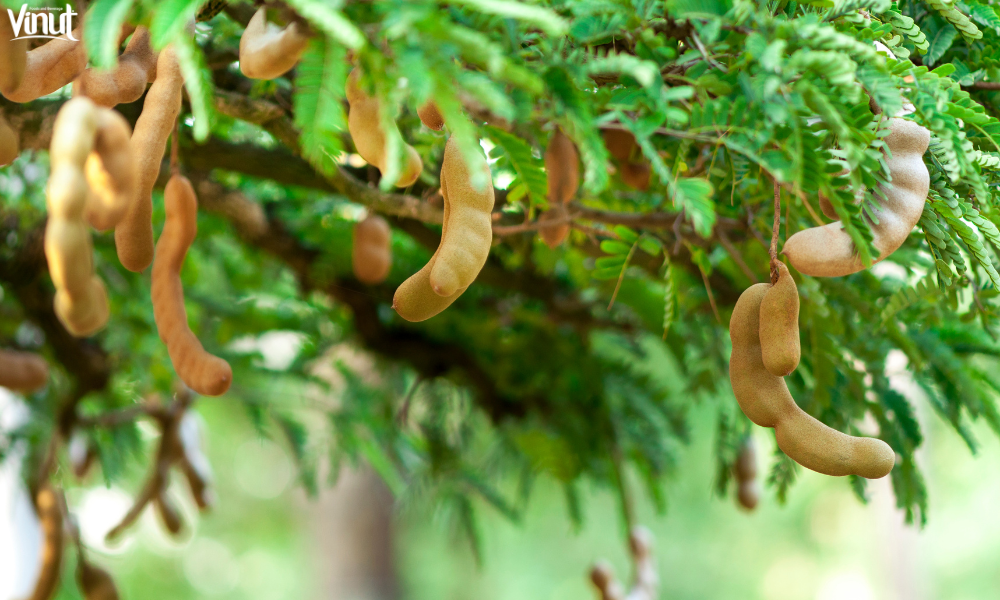Tamarind, the word alone invokes a sense of exotic allure, its mere mention tantalizing taste buds and igniting culinary imaginations. This tropical tree fruit has been treasured for centuries, not only for its unique flavor but also for its wide range of culinary, medicinal, and cultural applications.
In this comprehensive article, VINUT delves deep into the world of tamarind, exploring its origins, diverse uses, health benefits, and culinary wonders. Join us on this flavorful journey!
What is Tamarind?
Tamarind, scientifically known as Tamarindus indica, is a leguminous tree native to tropical Africa. Its distinctive pod-like fruit contains a sweet yet tart pulp, often used as a flavoring agent in various cuisines worldwide. The tree of this fruit can grow up to 25 meters tall and produces fruit pods that house the tangy treasure within.

A Taste of This Fruit
The flavor profile is truly unique. Its pulp is known for its harmonious blend of sweetness and tartness, with a hint of sourness that tickles the taste buds. When ripe, the pulp has a rich, earthy sweetness, while young fruit delivers a more intense, sour punch. This unparalleled flavor makes it a culinary favorite in both sweet and savory dishes.

Culinary Uses

- Cooking: It is a versatile ingredient in the kitchen. It’s a key component in many Indian, Thai, and Mexican dishes, where it is used to impart its characteristic tanginess. From curries and chutneys to soups and sauces, tamarind adds depth and complexity to a wide range of recipes.
- Beverages: This fruit is often used to prepare refreshing beverages, such as juice, soda, and margaritas. These drinks offer a delightful blend of sweet and sour notes, making them popular choices, especially in warm climates.
- Candy and Snacks: The pulp of this fruit can be processed into candies, snacks, and jams, providing a convenient way to enjoy its unique taste. These candies are particularly famous for their chewy texture and intense flavor.
- Based Sauces: The fruit is a key ingredient in sauces like Worcestershire sauce and HP Sauce, enhancing their tangy and umami qualities. These sauces are often used as condiments or marinades.
- Desserts: The sweet-sour profile shines in desserts like tamarind sorbet, tamarind pie, and tamarind-infused ice cream, adding a delightful twist to traditional sweets.
Tamarind in Global Cuisines

- Indian Cuisine: This fruit is a staple in Indian cooking, where it plays a crucial role in dishes like sambar, rasam, and tamarind rice.
- Thai Cuisine: Thai cuisine features this fruit prominently in dishes like Pad Thai and various dipping sauces.
- Mexican Cuisine: Mexican mole sauces often incorporate it for a distinctive flavor.
- African Cuisine: It is used in African dishes, such as jollof rice and tamarind-infused stews.
Health Benefits

- Rich in Nutrients: This fruit is a good source of essential nutrients like vitamins (A, C, and K), minerals (potassium, magnesium, and calcium), and dietary fiber.
- Digestive Aid: It is renowned for its digestive properties. It can alleviate indigestion and constipation due to its high fiber content.
- Antioxidant Properties: The fruit contains antioxidants, such as polyphenols and flavonoids, which help combat free radicals and reduce oxidative stress.
- Anti-Inflammatory: It has anti-inflammatory compounds that can help reduce joint pain and inflammation.
- Weight Management: The fiber in this fruit can promote a feeling of fullness, aiding in weight management by reducing overeating.
The Fruit in Culture and Tradition

- Festivals and Rituals: In some cultures, it is offered during religious ceremonies and festivals as a symbol of purity and auspiciousness.
- Traditional Medicine: This fruit has been used in traditional medicine systems like Ayurveda for its various health benefits.
- Natural Dyes: The pulp of this fruit has been employed as a natural dye for textiles, resulting in beautiful earthy tones.
Tamarind Sustainability and Cultivation
Cultivation is sustainable, as the tree is resilient and requires minimal care once established. The fruit pods are harvested when fully ripe, ensuring the sustainability of tamarind production.

Tamarind, with its captivating blend of flavors and versatile uses, is truly a gem in the world of culinary and natural treasures. Its rich history, wide-ranging applications, and health benefits make it a true wonder of nature. Whether you encounter it in your favorite dish, a refreshing beverage, or a traditional celebration, it never fails to leave a lasting impression.


 Juice Concentrate
Juice Concentrate Vegetable juice
Vegetable juice Juice Milk
Juice Milk Stand Up Pouches
Stand Up Pouches









